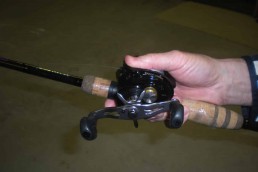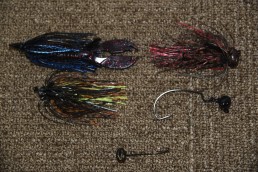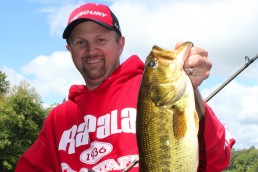SHARE THIS POST
A rifle and a shotgun are both guns, but would you use a .30-06 for duck hunting?
Well, not unless you were a damn good shot. Baitcasting and spinning can both be used for some of the same fishing applications, but there are a number of approaches that definitely work better with baitcasting gear.
“Keep your spinning outfits,” says Don Keenan, a multi-species angler, who has fished walleyes professionally, “but using the right baitcasting equipment can make a lot of your presentations a good deal easier.”
He says the most important thing to consider is a left-handed retrieve model.
“For anglers using spinning gear, the left-hand retrieve is already ‘normal.’ You won’t have to switch hands to retrieve or learn how to set the hook over again.”
Second, he says the low-profile models fit the palm well and that design advances have the gearing placed in a larger- diameter package that now sits below the handle.
“That, and the quality of materials, make today’s reels smoother and longer lasting. High-resistance lures, like big crankbaits and larger bladed spinnerbaits, are virtually made for level winds,” he said. “It makes interpreting the bait vibration and strike much easier.”
Baitcasters excel in fishing heavy cover, too. A heavier action rod, a power-type reel and stout line like 60-pount-test Power Cast braid or 25-pound-test mono, is a perfect match for flipping, pitching or punching baits through cover.
For the setup, good starting points are 6- to 6-foot 6-inch medium or medium-heavy rods. The 6:2:1-geared reels can handle everything from speedy buzzbaits to small-billed cranks. A 5:1:1 has the power for bigger baits and winching fish out of cover, but there’s always room for specialization down the road. Many of today’s anglers are trending toward longer rods, but the 6-foot-plus rods are still workhorses.
Getting started
“It’s easier learning to throw baitcasters with braided line because it is less stiff and has no memory,” Keenan says. “Monofiliment is a good second. Save the fluorocarbon for when you get more proficient, because it is stiffer. I do suggest using a fluorocarbon leader on braid or mono to make the bait end of the line less visible in clear water.”
For optimum casting distance, he recommends adjusting the spool tension knob by the handle so that when you put the reel in free spool the bait drops “herky-jerkey,” with just a little shake of the rod tip. Getting the tension knob set right definitely helps avoid overruns.
Are you enjoying this post?
You can be among the first to get the latest info on where to go, what to use and how to use it!
To cast, lower the bait about 1 foot down from the rod tip, as this helps keep the setup balanced. Use the magnetic brake on the outside of the reel too, as it exerts force on the spool to help avoid backlashes. Start with setting it at 3 or 4. Some reels have centrifugal brakes beneath the reel’s side plate but the magnets can be adjusted without opening the reel. Then, you can dial them in to your most comfortable setting.
“When overhand casting, hold the rod so the reel is sideways,” Keenan says. “That way, it follows the natural rotation of your arm and is more accurate. The reel should be top-up to throw sidearm. Also, keep your thumb on the plate on the reel’s top front to ‘feather’ the cast down to the water.”
Near the end of the cast, as the bait starts to drop, the spool is still turning fast. He says you should slip your thumb lightly onto the spool as the bait starts its decent. The area right below the top joint of your thumb should be what you use to feather the line to avoid backlashes. Keenan says that with a little practice it becomes second nature.
Don’t forget—throw lighter baits with a light setup, and heavy with heavy. This avoids a lot of potential problems. And when you practice, trim the hook off an old jig of the weight you will be throwing and use it as a practice plug. You’ll get a truer reading of how you’ll be able to cast with the real thing.
Consider casting with two hands; a lot of rods have the longer “trigger stick” handle designs that help with accuracy. Using both hands also helps avoid fatigue.
More useful ‘tips’
Old braided line makes perfect backing because it doesn’t absorb water. And serious anglers spool backing line on a reel first and attach good line to that.
Keenan recommends using 70 yards of quality line, and that putting too good a line deep into the spool is a waste of money.
To help avoid backlashes, with a full spool, make an average long cast, he says. And when it hits, strip out about three or four good pulls of line. Then, take about 6 inches of a strip of electrical tape and apply it over the line remaining on the spool. Slowly retrieve until the tape covers the remaining line. The result is what you will need to make a good cast and minimizes backlashes.
Braided lines continue to improve, but they can dig into the line on the spool. Keenan says that if you do use braid, don’t go lighter than a 30- or 40-pound-test line. As another money saver, since braid is slower to break down, you can strip off the line and reverse it for more use as well.
Baitcast drags are extremely reliable, but Don prefers to tighten the drag down then depress the reel into free spool and use thumb pressure to control a fish.
“I use baitcast for most of my fishing, but spinning equipment will always have a place, especially when using baits that are 1/16 ounces and lighter. But using both applications for what they’re designed for can really help you maximize your fish- catching potential.”
MWO
SHARE THIS POST
Did you enjoy this post?
You can be among the first to get the latest info on where to go, what to use and how to use it!
Tom Luba
Tom Luba is a freelance outdoor writer living in New London, Wis. He has written about open water fishing for more than 35 years.



